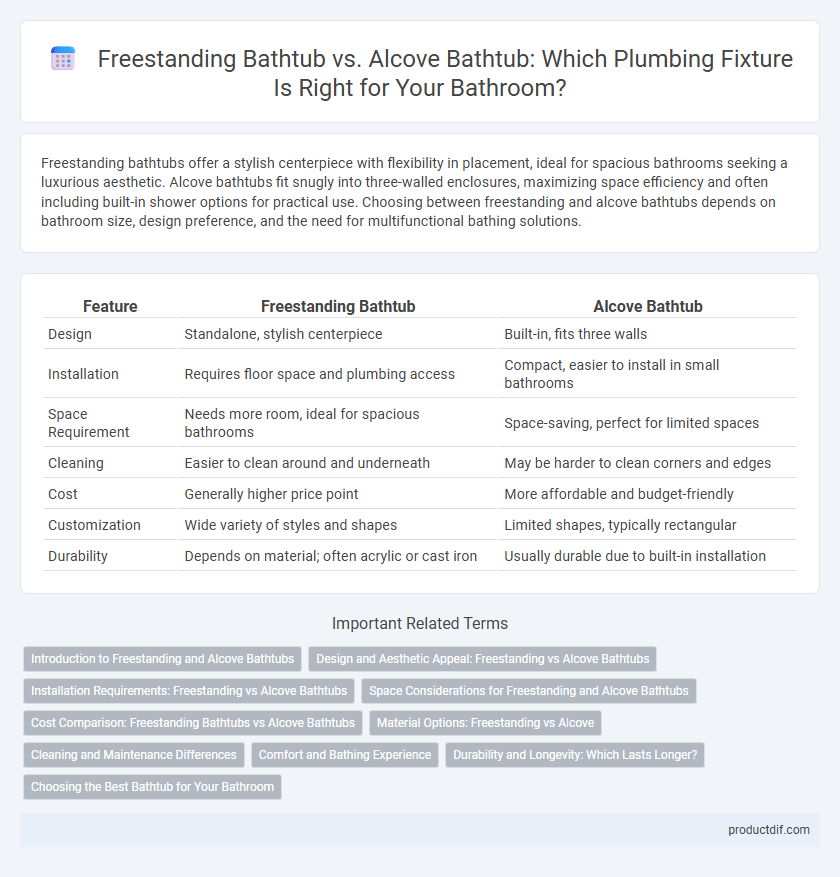Freestanding bathtubs offer a stylish centerpiece with flexibility in placement, ideal for spacious bathrooms seeking a luxurious aesthetic. Alcove bathtubs fit snugly into three-walled enclosures, maximizing space efficiency and often including built-in shower options for practical use. Choosing between freestanding and alcove bathtubs depends on bathroom size, design preference, and the need for multifunctional bathing solutions.
Table of Comparison
| Feature | Freestanding Bathtub | Alcove Bathtub |
|---|---|---|
| Design | Standalone, stylish centerpiece | Built-in, fits three walls |
| Installation | Requires floor space and plumbing access | Compact, easier to install in small bathrooms |
| Space Requirement | Needs more room, ideal for spacious bathrooms | Space-saving, perfect for limited spaces |
| Cleaning | Easier to clean around and underneath | May be harder to clean corners and edges |
| Cost | Generally higher price point | More affordable and budget-friendly |
| Customization | Wide variety of styles and shapes | Limited shapes, typically rectangular |
| Durability | Depends on material; often acrylic or cast iron | Usually durable due to built-in installation |
Introduction to Freestanding and Alcove Bathtubs
Freestanding bathtubs offer a sculptural centerpiece with their standalone design, allowing flexible placement and a variety of styles from vintage clawfoot to modern minimalist. Alcove bathtubs fit snugly into a three-wall enclosure, maximizing bathroom space and often incorporating shower functions for dual use. Choosing between freestanding and alcove bathtubs depends on bathroom layout, style preference, and the need for integrated shower capabilities.
Design and Aesthetic Appeal: Freestanding vs Alcove Bathtubs
Freestanding bathtubs offer a sculptural, luxurious centerpiece that enhances modern and eclectic bathroom designs with their versatile placement and elegant contours. Alcove bathtubs maximize space efficiency by fitting snugly within three walls, providing a streamlined, built-in look ideal for traditional and compact bathroom layouts. The choice between freestanding and alcove bathtubs significantly impacts the bathroom's visual flow and overall aesthetic harmony.
Installation Requirements: Freestanding vs Alcove Bathtubs
Freestanding bathtubs require open floor space and accessible plumbing connections, often necessitating reinforced flooring to support their weight and flexible water supply lines for versatile placement. Alcove bathtubs are installed against three walls, requiring precise measurements for a snug fit, standard plumbing alignment, and typically built-in overflow and drain systems compatible with existing wall fixtures. Proper installation of either type impacts bathroom layout, necessary structural modifications, and the overall plumbing configuration.
Space Considerations for Freestanding and Alcove Bathtubs
Freestanding bathtubs require more open floor space, making them ideal for larger bathrooms where a focal design element is desired. Alcove bathtubs fit snugly into three-walled recesses, maximizing space efficiency in smaller or narrow bathrooms. The choice between freestanding and alcove tubs depends heavily on bathroom layout and available square footage, with freestanding tubs offering aesthetic freedom and alcove tubs optimizing compact areas.
Cost Comparison: Freestanding Bathtubs vs Alcove Bathtubs
Freestanding bathtubs typically cost between $1,200 and $5,000 or more, reflecting their designer appeal and installation flexibility, while alcove bathtubs range from $300 to $1,500, making them a more budget-friendly option. Installation costs for freestanding tubs are higher due to additional plumbing and floor reinforcement requirements, whereas alcove tubs benefit from straightforward installation within existing walls. When considering both purchase and installation expenses, alcove bathtubs offer a cost-effective solution for budget-conscious homeowners compared to the premium pricing associated with freestanding tubs.
Material Options: Freestanding vs Alcove
Freestanding bathtubs commonly feature materials like acrylic, cast iron, and stone resin, offering a variety of textures and finishes that enhance bathroom aesthetics. Alcove bathtubs are typically constructed from acrylic, fiberglass, or enameled steel, prioritizing durability and ease of installation within a three-wall enclosure. Material selection impacts heat retention, maintenance, and style compatibility, with freestanding tubs often providing more sculptural appeal and alcove tubs emphasizing practicality.
Cleaning and Maintenance Differences
Freestanding bathtubs require cleaning of all exterior surfaces, including the often hard-to-reach sides and undersides, making maintenance more labor-intensive compared to alcove bathtubs. Alcove bathtubs have three walls surrounding the tub, which reduces exposed surfaces and simplifies cleaning by limiting access to fewer areas. The smooth, enclosed design of alcove tubs often allows easier removal of soap scum and mildew, whereas freestanding tubs demand more regular attention to prevent buildup on all visible surfaces.
Comfort and Bathing Experience
Freestanding bathtubs offer superior comfort with their spacious design and ergonomic shapes, allowing for a more relaxing and luxurious bathing experience. Alcove bathtubs, while more compact, provide practical comfort through built-in armrests and back support, ideal for smaller bathroom spaces. The choice impacts water capacity and ease of entry, with freestanding tubs often providing a deeper soak and alcove tubs ensuring stability and convenience.
Durability and Longevity: Which Lasts Longer?
Freestanding bathtubs, typically made from materials like cast iron, acrylic, or stone resin, offer excellent durability and can last several decades with proper maintenance. Alcove bathtubs, often constructed from fiberglass or enameled steel, provide sturdy performance but may show wear faster due to their built-in installation and exposure to wall moisture. Cast iron alcove tubs generally outlast acrylic freestanding models, but maintenance and material quality ultimately determine longevity in both types.
Choosing the Best Bathtub for Your Bathroom
Freestanding bathtubs offer a stylish, sculptural centerpiece ideal for spacious bathrooms, providing versatile placement and easy access from all sides. Alcove bathtubs maximize space efficiency by fitting snugly into three-wall recesses, making them perfect for smaller bathrooms and those prioritizing functionality over ornate design. Consider bathroom size, layout, and personal bathing preferences to select the best bathtub that balances aesthetics, installation complexity, and maintenance requirements.
freestanding bathtub vs alcove bathtub Infographic

 productdif.com
productdif.com